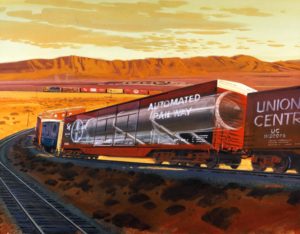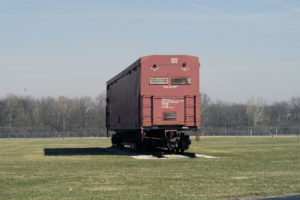By Wes O’Donnell
Veteran, U.S. Army and Air Force. Managing Editor, InMilitary.com.
By the early 1980s, heightened Cold War paranoia led many military leaders in the United States and the Soviet Union to question the survivability of stationary nuclear missile silos in the event of a full-scale nuclear exchange. Consequently, both sides worked on other methods of making Intercontinental Ballistic Missiles (ICBMs) mobile and harder to detect.
Soviet Union Created Trains Capable of Launching Nuclear Missiles in 1983

In 1983, U.S. intelligence discovered that the Soviet Union had deployed a rail-based system that could move nuclear-armed trains 622 miles per day and remain undetected. The trains would be able to launch missiles hidden in box cars from any location along a route.
Known as the SS-24 Scalpel, the missile used on the nuclear train was only test-fired once during an exercise in the Kostroma region, about 205 miles (330 km) from Moscow. The missile hit its target in Kamchatka in the Russian Far East. Most troubling was that American monitors were unable to fix the train’s coordinates either before or after the launch.
US Responded to Russian Nuclear Train Threat with Rail System for ICBMs
Acting on this intelligence in 1986, President Ronald Reagan approved the development of a rail system to house some of the Peacekeeper Intercontinental Ballistic Missile force.
According to the National Museum of the Air Force, “To increase survivability of this force, 50 Peacekeepers would be deployed in existing Minuteman silos and 50 more would be mounted on 25 USAF trains, two per train. Each train would consist of two locomotives, two security cars, two missile launch cars housing the missiles, one launch control car, one fuel car and one maintenance car. Each launch car carried one Peacekeeper ICBM in a launch tube that could be elevated to fire the missile from the bed of the car.”
These nuclear trains would be stored in reinforced bunkers except in times of heightened tension. In the event of a threat, they would be dispersed around the nation’s many rail lines disguised as standard freight trains.
Officially known as the Peacekeeper Rail Garrison, the prototype car was delivered to the U.S. Air Force for evaluation and testing in October 1990. But the Cold War ended the next year with the collapse of the Soviet Union and the cancellation of the project. Only two cars were ever built, one of which is on display at the National Museum of the Air Force at Wright-Patterson Air Force Base, Ohio.

Was President Reagan Riding the Crazy Train?
Although it may seem that placing nuclear missiles among civilian freight rail traffic was a strange idea, there are strategic advantages to dispersing nuclear missiles in this manner.
A stationary nuclear missile silo in Montana, for example, is certainly on a target list in a Moscow intelligence vault. If nuclear missile “survivability” is the goal, one can either spend taxpayer dollars hardening nuclear siloes that the enemy knows about or spend money making nuclear missiles mobile and camouflaging them.
The big issue is cost versus benefit. According to the Government Accountability Office’s 1989 report, the Peacekeeper Rail Garrison Missile System was projected to cost $7.4 billion ($15 billion in 2019 dollars).
For fiscal year 2019, President Trump proposed an increase in defense spending to $686.1 billion. That means that if the rail project were in existence today, it would equal all of the foreign military aid the United States gives to all of its allies.
Launching Missiles from Trains Has Its Disadvantages
In addition, a 2014 Rand Corporation study pointed out that missile launches on trains have some distinct disadvantages. First, maintaining an intercontinental missile on a moving train is far more difficult than maintenance in a stationary silo. Plus, rail lines can be blocked by snow, rock sides and derailments.
Furthermore, there are only so many rail lines in a given area. With advances in satellite surveillance, an adversary can focus on a few key areas. If that adversary were to positively identify a missile train, the payload would be a sitting duck and much more vulnerable than an ICBM in a concrete silo.
Both Sides Abandoned Nuclear Trains After Cold War Ended
The end of the Cold War brought a welcome respite from the constant tension of assured mutual destruction. Today, Russia’s last rail missile car is in the central museum of the Oktyabrskaya Railway at St. Petersburg’s Warsaw Terminal, while America’s lone missile car sits in a field in Ohio.
Looking back 30 years, the psychology of the Cold War was absurd. The United States was never going to preemptively attack the Soviet Union. This means that the only purpose of a moveable weapons system like this was for deterrence and, failing that, as a punitive weapon for being attacked first.
These freight cars are a sobering reminder of the lengths a nation will go to ensure that in the event of an unwinnable war, we take the other team out too.
Nuclear proliferation means we all ride the crazy train into extinction.

Comments are closed.